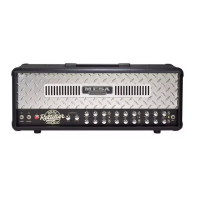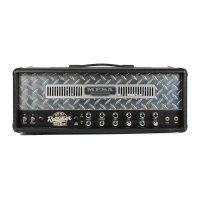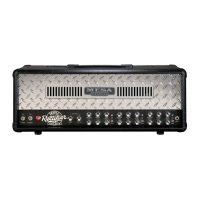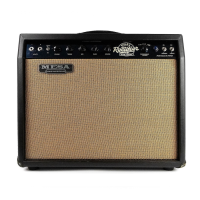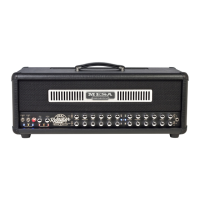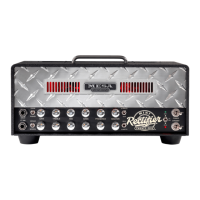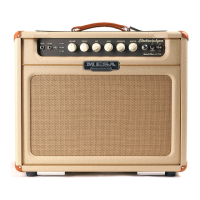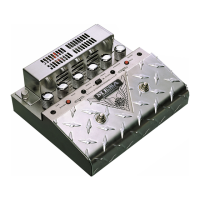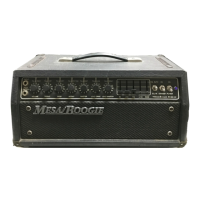Do you have a question about the Mesa/Boogie Dual Rectifier Trem-o-Verb and is the answer not in the manual?
Important safety guidelines for operating the amplifier, covering moisture, grounding, and handling.
Notes for export models regarding voltage and grounding standards.
Guidance on following proper usage instructions for optimal performance and safety.
Introduction to the TREM-O-VERB, highlighting its features and unique design aspects.
Detailed description and visual guide to the controls and jacks on the front of the amplifier.
Detailed description and visual guide to the controls and jacks on the rear of the amplifier.
Step-by-step instructions for safely powering on the amplifier.
Explanation of the different channels (Orange, Red) and sound modes.
Detailed explanation of how Gain, Treble, Middle, and Bass controls affect the sound.
Explanation of the Presence and Reverb controls and their impact on tone.
Guide to Master, Loop Active Master, and Tremolo controls for sound management.
Instructions for powering the amplifier on and using the standby mode.
Description of Power Select options and the role of the fuse.
Explanation of Rectifier Select, Ground, and Bias Switch settings.
Details on the effects loop, loop selection, and slave level output.
Guide to speaker outputs, external switching, and channel cloning.
Example settings for achieving specific tones and playing styles.
Space provided for users to record their custom amplifier settings.
Information on identifying and resolving tube noise and microphonic issues.
Steps to diagnose and identify common power tube failures.
Methods for pinpointing the source of tube noise within the amplifier.
Guide to troubleshooting common problems with pre-amp tubes.
Explanation of why Mesa amplifiers do not have user-adjustable bias controls.
Details on amplifier voltage, current, and the function of bias settings.
Discussion on tube matching and comparison of different biasing techniques.
Important safety guidelines for operating the amplifier, covering moisture, grounding, and handling.
Notes for export models regarding voltage and grounding standards.
Guidance on following proper usage instructions for optimal performance and safety.
Introduction to the TREM-O-VERB, highlighting its features and unique design aspects.
Detailed description and visual guide to the controls and jacks on the front of the amplifier.
Detailed description and visual guide to the controls and jacks on the rear of the amplifier.
Step-by-step instructions for safely powering on the amplifier.
Explanation of the different channels (Orange, Red) and sound modes.
Detailed explanation of how Gain, Treble, Middle, and Bass controls affect the sound.
Explanation of the Presence and Reverb controls and their impact on tone.
Guide to Master, Loop Active Master, and Tremolo controls for sound management.
Instructions for powering the amplifier on and using the standby mode.
Description of Power Select options and the role of the fuse.
Explanation of Rectifier Select, Ground, and Bias Switch settings.
Details on the effects loop, loop selection, and slave level output.
Guide to speaker outputs, external switching, and channel cloning.
Example settings for achieving specific tones and playing styles.
Space provided for users to record their custom amplifier settings.
Information on identifying and resolving tube noise and microphonic issues.
Steps to diagnose and identify common power tube failures.
Methods for pinpointing the source of tube noise within the amplifier.
Guide to troubleshooting common problems with pre-amp tubes.
Explanation of why Mesa amplifiers do not have user-adjustable bias controls.
Details on amplifier voltage, current, and the function of bias settings.
Discussion on tube matching and comparison of different biasing techniques.
| Wattage | 100 Watts |
|---|---|
| Preamp Tubes | 5 x 12AX7 |
| Power Tubes | 4 x 6L6 |
| Channels | 2 Channels |
| Reverb | Yes |
| Effects Loop | Yes |
| Controls | Gain, Master, Treble, Mid, Bass, Presence, Reverb, Tremolo |
| Tremolo | Yes |
| Footswitch | Tremolo |
| Effects | Tremolo, Reverb |
| Speaker Outputs | 4, 8 Ohm |
